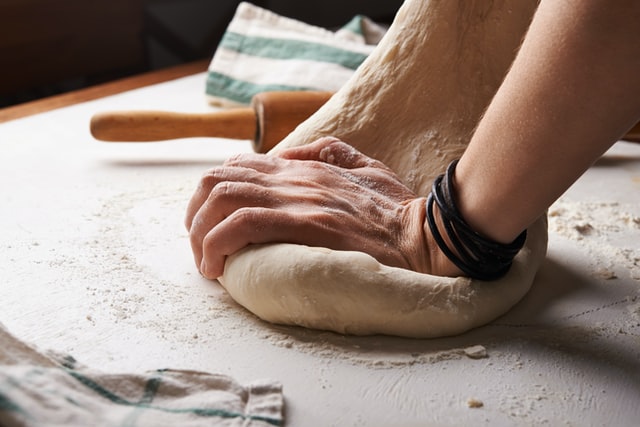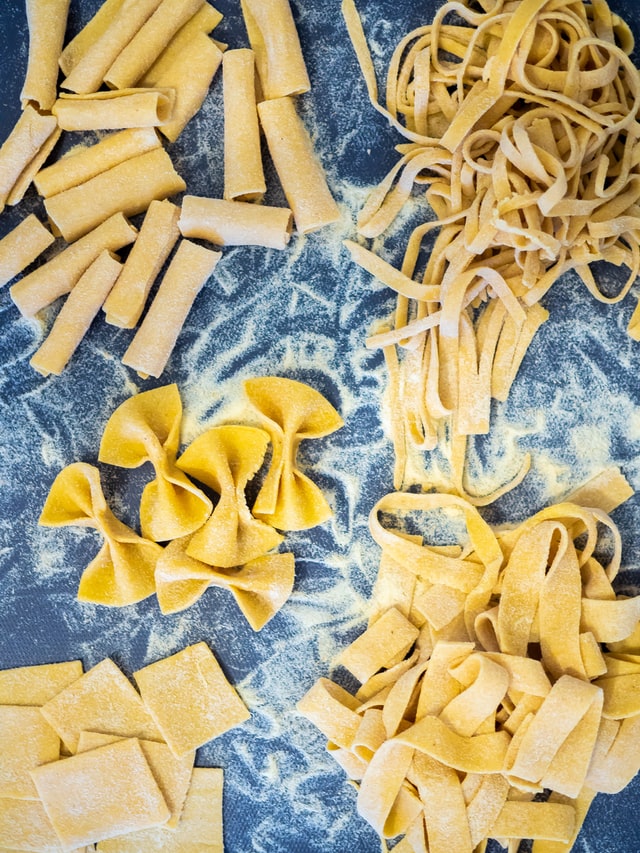Fresh egg pasta dough base recipe

This is the basic older style formula for home made egg pasta, very much like any Italian grammy would make! It may seem daunting, but it is a simple pleasure that you can enjoy every day or whenever you have time. Keep in mind that fresh pasta cooks a lot faster than dry pasta! Follow this 5-step guide, you will learn how to transform 2 basic ingredients into fresh pasta! Are you ready to try?

This is a base recipe for 6 portions of fresh egg pasta. As a rule of thumb you should use 100 grams of flour (3/4 cups) and 1 egg per each person to serve.

Fresh pasta is cooked -as normal pasta- into boiling water. It just take quite less time to be cooked al dente. Usually fresh pasta is ready in 1-3 minutes and you can understand that it’s ready when it floats to the top of the cooking water.
- 6 servings
- About 1.5 hours (plus time to rest)
- 2 minutes
Ingredients
- 400 grams (3 cups) Type 00 flour or unbleached all-purpose flour
- 4 large eggs
- A bit of more flour is needed to lightly flour the working surface as needed during the process
Directions
-
Make a ball
Make a mound of flour on a marble or wooden work board. Make a well in the mound’s middle. Beat the egg with a fork in a medium bowl until mixed, then dump it into the well. Continue to beat the egg mixture with a fork, steadily pulling in flour from the well’s sides until the egg is fully absorbed by the flour. Wet your hands under the water tap if necessary and begin to work the dough. Clean your hands and the work surface after the dough has shaped.
-
Hand kneading, kneading and kneading
Clean the work surface by scratching it with a bench scraper first, then rubbing it down with a humid kitchen cloth. Sprinkle some flour on the working surface once more. Knead the dough by pressing the heel of one hand deep into the ball while holding the fingers high, then pressing back on the dough while pulling it away from you tightly. The dough will stretch and curl like a large shell under your hand. Turn the dough over, then press into it with the knuckles of one hand, then the knuckles of the other; repeat about ten times with each hand’s knuckles. For around 10 to 20 minutes, repeat the stretching and knuckling process, adding more flour if required to avoid sticking, until the dough is smooth. If the dough is rough and crumbly, add a little lukewarm water to make it malleable. If it’s too wet, apply flour a tablespoon at a time before it’s manageable. Create a smooth ball out of the pastry.
-
Time to rest (and to choose the shape)
Put the the dough in a shallow bowl and cover with cling film. Leave the dough at rest for at least 30-45 minutes at room temperature or up to overnight in the refrigerator – this is a crucial move, so don’t miss it! Room temperature in south of Italy could easily span from 20°C to 30°C. Keep in mind that the room temperature, the quality of the flour, eggs’s size, and a variety of other factors such as air and humidity will all affect the texture of the dough. If your room temperature is too cold let it rest for 45-60 minutes. While the dough is resting, if not already done, you can decide what shape of pasta you will cut. There are numerous shape of pasta and we listed most of them. Get inspired by our collection of long, medium, short, filled pasta. You can make pappardelle, tagliatelle, lasagne, orecchiette, macaroni. It’s up to you.
-
Time to roll
When resting time is due make a rough circle out of the pastry. Gently sprinkle a bit of flour again the clean work surface before placing the dough. Start rolling the dough with a rolling pin like you would with any pastry crust. Start from the middle and work your way out to the outer edges. Repeat several times following different directions. Spin the dough a quarter turn and repeat all the way around. When the dough begins to cling to the surface or the rolling pin, sprinkle it with a tiny amount of flour. Some chefs would teach that the sheet should be basically transparent. With the rolling pin, press out and away from you, turning the dought between rolls, until the sheet of dough is 3 mm (1/8 inch) thin.
-
Shape it
At this point you shoud had enough time to decide what shape of pasta you are going to prepare. Do you know that some shape of pasta match better with some sauces and condiments than other? Let’s say for instace you would like to have tagliatelle. Move the sheet of dough around the rolling pin gently, then transfer it to your smooth, lightly floured as usual work surface. Cut the roll of dough into desired-width strips, then gently raise them in the air and place them on a dishtowel, apart. Repeat for the remaining dough sheets.
You are done! Congratulation on making your (first?) fresh handmade egg pasta! It’s time to celebrate with Pasta! Now you can cook the pasta for 1-3 minutes. Usually fresh pasta is ready as it floats to the top of the highly salted cooking water.
More delicious recipes
This is one of the many fantastic recipes available on this blog
